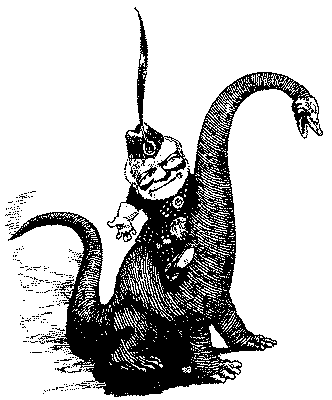

By J. LeRoy Kay in Carnegie Magazine, February 1951.
Carnegie Museum has long been famous for its Jurassic dinosaur collection. The most notable of these is the one named by J. B. Hatcher in honor of Andrew Carnegie, whose generosity made it possible to collect this and other related specimens in the collection. The word "Diplodocus" is taken from the Greek meaning "double-beam," and this particular dinosaur was so named because of the forked spines of the vertebrae. Ten replicas of Diplodocus carnegii have been sent to as many countries as gifts from Mr. and Mrs. Carnegie, so there is little doubt that this is the world's best-known dinosaur.
The skeleton in Dinosaur Hall at the Institute is a composite, that is, made up of the bones from more than one individual. It is seldom that a dinosaur is found in its entirety, and for this reason the missing parts are supplied from another individual or modeled from plaster or other media. The greater part of the skeleton was collected from the Morrison formation on Sheep Creek, in Albany County, Wyoming, by J. Wortman in 1899, and supplemental parts were collected by O. A. Peterson in 1900 at the same site. It was assembled in the old Exposition Building at the Point and in 1907 mounted in the Fossil Reptile Gallery at the Museum.
Exhibited with the Diplodocus is Apatosaurus (from the Greek meaning "deceitful lizard"), which was named "louisae" by W. J. Holland in honor of Mrs. Andrew Carnegie. The Apatosaurus is also known as Brontosaurus. Apatosaurus louisae was the first specimen collected from the Carnegie Museum Dinosaur Quarry, now known as the Dinosaur National Monument, in northeastern Utah.
In August 1909 Earl Douglass discovered a series of six articulated caudal vertebrae exposed by weathering on a sandstone ledge, a few miles west of Split Mountain Canyon, Uintah County, Utah. On the following September first, Douglass with a crew of men began excavating this find, which proved to be a very complete skeleton. In excavating it, other specimens were uncovered, and during the thirteen years that Carnegie Museum worked this deposit seven hundred thousand pounds of fossils and the matrix surrounding them were shipped to Pittsburgh. A number of fairly complete large and small dinosaurs were found here, together with a number of skulls, which are rarely found with Jurassic dinosaurs. Apatosaurus was mounted beside Diplodocus in 1913, and Carnegie Museum is the only institution that exhibits both of these dinosaurs.
To the casual observer these two skeletons may appear to be very much alike. There are, however, many differences in their structure. Apatosaurus is much the heavier although shorter. The skulls probably show the greatest difference. The skull of Apatosaurus is considerably larger. The teeth are fairly broad and spatula-shaped, whereas Diplodocus has small pencil-shaped teeth. They are both vegetable eaters, but it has been suggested that they may have eaten mollusks as well. In several instances the matrix or rocks containing these dinosaur bones also contained a great number of fresh-water clam shells, and it is thought by some that from eating these shells the animals got the calcium required to build up such enormous bone structure.
I doubt that more than a few of the visitors to the Dinosaur Gallery in the Museum observe that two or more caudals, or tail vertebrae, of both these specimens are joined together. This occurs at a point about where the tail would reach the ground if the animal were to rear up on its hind feet, using its tail for a tripod--which it probably did, especially while in the water. This would bring a strain on these vertebrae which may account for the extra bone growth that caused the bones to coalesce. This is known as spondylitis deformans or might be thought of as arthritis of the vertebrae.
Diplodocus and Apatosaurus as well as many of the other dinosaurs probably spent a good part of their time in the water, where they fed upon succulent water plants and escaped their natural enemies, the carnivorous dinosaurs living at the same time. There are a number of anatomical features that suggest their semiaquatic habit. The external nostrils are situated high on the head, which would enable the animal partly to submerge the head and still breathe. This is especially true of Diplodocus.
Dinosaur fossils are found on all the continents of the earth and they are found in both eastern and western United States. The greatest deposit of Jurassic forms are found along the Rocky Mountain chain. Of course, when the great dinosaurs were living, there were no Rocky Mountains. The area was a series of inland seas, rivers, and lakes. The plants were different, as was also the climate. It was not until the close of the dinosaurs' reign that the Rocky Mountains were thrust up and the country became somewhat like it is today. In fact, there were world-wide movements of the earth's crust with mountain-building at that time.
Some scientists believe that this mountain building and the resultant changes of ecological conditions caused the extinction of the dinosaurs. This is only one of several theories as to their disappearance, and we may never know all the factors causing the extinction of these interesting animals that lived for a period of over one hundred million years of the earth's history.